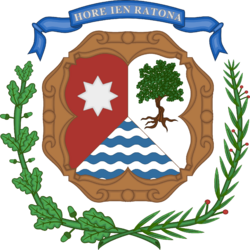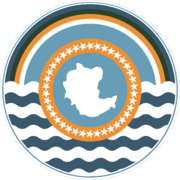National Badge of Freice
| Emblem of Freice | |
|---|---|
 | |
| Versions | |
 Stylised version used by the government | |
 Stylised version used by the Kivunna | |
| Armiger | Country of Freice |
| Adopted | 10 August 2021 |
| Crest | Dove |
| Blazon | A shield quartered by a cross azure, first and fourth quarter gules, a sun radiant Or; second and third quarter, four bars four bars azure, vert, orange, argent; and in nombril point a star radiant Or. |
| Use | The emblem is used on all Acts of the Kivunna and government departments. |
The Emblem of Freice (Freician: Temo oe Faio), officially the Public Emblem of the Country of Freice, is the national symbol of the Country of Freice, used alongside and in conjunction with the national flag.[1] It was adopted in August 2021 following the 2021 Freician coup d'état, and formalised the following month.[2] Following the creation of a new Island Meeting in January 2022 after the fall of the Common Wealth government, the emblem was reaffirmed as the national emblem.[3]
It bears a traditional Freician shield used by warriors during the Qaba Dance, bearing a blue cross.[4] The first and fourth quadrants of the shield depict a yellow sun on a red background, and the second and third a representation of the ethnic flag of the Freician people. In the centre is a star. The emblem was designed by Qogra Egel, based on a design he originally created in 1969.[5]
Description
The emblem takes inspiration from western heraldic practices, with the blazon making use of a shield, albeit a traditional Freician shield in place of a standard three-point one. According to Egel, the design incorporates various references to Freician history, identifying three distinct phases in Freician history.[6]
The yellow sun on a red background represents Freice prior to Riamese colonisation. Although no national flag was used to represent the island at this time, this design was commonly used as a heraldic banner to represent the island's monarchs. The colour red was also commonly used in the form of a solid-coloured banner to represent nobility and the elite classes.[7] The design was adopted because, according to Egel, Freice's history prior to colonisation was driven by and primarily recorded through the activities of these classes, who provide the only known glimpse into this pre-colonial period.<[5][8] The Freician ethnic colours is used to represent both the Freician people and the Freician country, having been used as the interim flag prior to the adoption of the current flag. The original design was created whilst this initial flag was in use, being retained as an additional reference to the initial political movement from which the colours originated.
The blue cross is a reference to Freician colonisation, dividing the quadrants into the 'past' and the 'present'. The cross itself represents the four corners of the country, with the colour symbolising the sea. The colour also links back to the current flag, having been changed from white to be more closely associated with contemporary Freician symbolism.[9] In the centre is a star, representing the aspirations of the Freician people.
History
Freice was granted its first emblem in 1949 when the colonial government adopted a seal to replace the use of Riamese state symbols in Freician colonial government activities.[10] The seal featured the Riamese coat of arms with 'Government-General of Freice' around it. The seal was later adapted, with a wreath added around the Riamese coat of arms in 1958.[11]
Upon self-government in 1969, the colonial seal was retained, although heavily amended. The Riamese coat of arms was replaced with a stylised depiction of the island of Freice with the wording replaced by 'Seal of the Government of Freice.' This was an interim emblem for the exclusive use of government authorities and was not intended to be a permanent state symbol.[12] The first permanent emblem was a shield divided into two halves. In the left half was a stylisation of traditional Freician work tools on a green background. In the right half was a representation of a fishing scene.[13]
In 1980, a new emblem was adopted in line with the federal school of Riamese heraldry.[14] The seal consisted of a blue disc of the same colour as the field on the Freician national flag, representing the sea. In the bottom half of the disc was a depiction of the ocean, whilst the top half featured a depiction of the Frecian ethnic flag in the form of a rainbow, symbolizing the island's emergence from the ocean. In the centre was an orange disc featuring a circle of 38 stars, representing the 38 fish from which the Frecian people evolved in ancient tribal mythology. A further blue disc was superimposed onto this, bearing a white silhouette of the island of Freice, with the central emblem representing the island within the ocean protected by the sun and the stars.[15]
Following the 2021 Freician Coup d'état, the current emblem was adopted. It was formally enshrined in law with the Law on the Establishment of National Symbols on 10 August 2021 and reaffirmed in the Schedules of Government passed on 1 September 2021.[16]
Regulations on use
Although the emblem of the nation, the constitution defines it as a government symbol:
The national state emblem shall be determined by law, to be adopted for the purposes of identification of state authorities.[17]
This regulation was carried over from the previous constitution, with no mechanism for the public use of the emblem. Consequently, the use of the national emblem without government permission is illegal, although there is no record of any prosecutions for it's unilateral use. Because of its legal position, there have been calls for the creation of a 'civic emblem' to be used alongside the Freician flag to represent the Freician nation in a non-government setting.[18]
Gallery
See also
References
- ↑ Law on the Establishment of National Symbols (PDF). Government of Freice. 4 September 2021. Retrieved 21 September, 2021.
- ↑ Transitional Law on the Reformation of National Symbols (PDF). Institute for Freician Political and Social Studies. 14 September 2021. Retrieved 20 September, 2021.
- ↑ "Meeting retains coup symbols". Radio and Television Freice. 22 January 2022. Retrieved 25 January 2022.
- ↑ Iqd, Pega, A. (2007). The National Encyclopedia of Freician History and Culture (2nd ed.). Guri.: University of Guri Press. pp. 99-102. ISBN 918-0-28319-399-2.
- ↑ 5.0 5.1 "Qogra Egel at 70". Tama Adune oe Faio. 18 January 2014. Retrieved 2 February, 2014.
- ↑ "The National Flag". www.visitfreice.fr. 18 August 2015. Retrieved 19 March 2017.
- ↑ (Flag of) Freice. Flags of the World. 8 August 2016. Retrieved 13 May 2018.
- ↑ "How I created my country's flag". Guri Telegraph. 1 February 2014. Retrieved 15 July 2014.
- ↑ "Why is blue an important colour in Freice?" Nashe Guardian. 16 June 2020. Retrieved 9 December 2020.
- ↑ "History of Freician national symbols". Institute for Freician Political and Social Studies. 13 January 2009. Retrieved 15 February, 2015.
- ↑ Sharman, Maria G. (2014) Expressions of Freician national identity'. Political and Social Centre, National Library of Riamo. 18 August 2015. Retrieved June 12, 2019.
- ↑ "Artistic developments in Freician political culture". Institute for Freician Political and Social Studies. 16 July 2005. Retrieved 28 March 2016.
- ↑ One photo (see "The Convening of the First Assembly of the Autonomous Republic of Freice, 1971,") shows the first use of this emblem (Image: Unknown).
- ↑ Svil, F.J., A History of Nativism (Saltstil University Press, 2012), p.99
- ↑ "Regulations on State Symbols" (PDF). Government of Freice. 14 January 2019. Retrieved June 19, 2019.
- ↑ Law on the Establishment of National Symbols (PDF). Government of Freice. 4 September 2021. Retrieved 21 September, 2021.
- ↑ "Constitution of the Country of Freice - Section 4(2)" (PDF). Kivunna. 28 June 2022. Retrieved 18 August 2022.
- ↑ "Calls for civic emblems to be created". Tama Adune oe Faio. 4 May 2020. Retrieved 21 June, 2020.
External links


